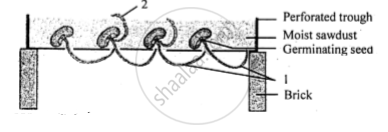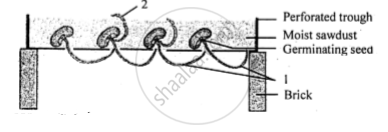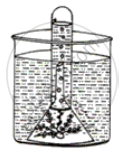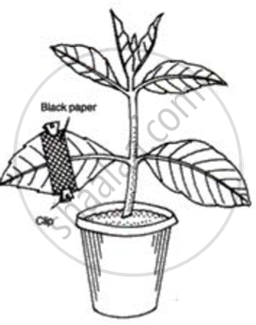Advertisements
Advertisements
प्रश्न
Name the molecules which are called assimilatory power? Why are they called so?
उत्तर
ATP and NADPH2 are called assimilatory power. They are called so because they provide the energy requirement for CO2 assimilation during the dark reaction of photosynthesis.
APPEARS IN
संबंधित प्रश्न
The individual flattened stacks of membranous structures inside the chloroplasts are known as :
A. Grana
B. Stroma
C. Thylakoids
D. Cristae
Given below is an experiment setup to demonstrate a particualr tropic movement in germinating seeds. Study the diagram and answer the questions that follow : 
Label the parts 1 and 2.
Given below is an experiment setup to demonstrate a particualr tropic movement in germinating seeds. Study the diagram and answer the questions that follow : 
What is Thigmotropism? Give one example.
An experiment was set up as shown in the figure alongside. Look at the figure and answer the following questions:
( i) What is the objective of this experiment?
( ii ) Which plant is used in this experiment?
( iii ) Which gas is evolved in this process?
( iv ) What will happen to the rate of evolution of this gas if a pinch of sodium
bicarbonate is added?
(v ) What will happen if the apparatus is kept in dark?

Name the following:
The principle site in a green leaf for photosynthesis.
The following statement is about photosynthesis in a green plant. Write whether it is True or False.
Photosynthesis results in a gain in dry weight.
The diagram alongside represents an experiment conducted to prove the importance of a factor in photosynthesis.

Study the same and then answer the questions that follow:
(i) Name the factor being studied in his experiment.
(ii) Why was the plant kept in a dark room before conducting the experiment?
(iii}Why was the experimental leaf then kept in
1. boiling water 2. methylated spirit?
(iv) Name the solution used to test for the presence of starch in the leaf.
(v) What will we observe in the experimental leaf at the end of the starch test?
(vi) Give a balanced chemical equation to represent the process of photosynthesis.
Choose the correct answer:
Which one of the following is the best reason for leaving a plant in a dark place before carrying out experiments on photosynthesis?
During photosynthesis, the oxygen in glucose comes from
Are the following statement true or false? Give a reason in support of your answer.
The rate of photosynthesis continues to rise as long as the intensity of light rises.
Photosynthesis in green plants is directly and indirectly dependent on so many plant structures.
Explain briefly the role of the following structures in this process is Phloem tissue in the leaf veins.
Photosynthesis in green plants is directly and indirectly dependent on so many plant structures.
Explain briefly the role of the following structures in this process is Stomata.
What is the importance of photosynthesis in the life of the following:
Non-green plants
Oxygen given out during photosynthesis comes from water. Explain this statement.
Name the following:
The immediate product of photosynthesis.
Choose the Correct Answer:
Which one of the following would not be a limiting factor for photosynthesis?
Column ‘II’ is a list of items related to ideas in Column ‘I’. Match the term in Column ‘II’ with the suitable idea given in Column ‘I’.
| Column I | Column II | ||
| (i) | Grana | (a) | Decomposers |
| (ii) | Autotrophs | (b) | Light reaction |
| (iii) | By-products of photosynthesis | (c) | Animals |
| (iv) | Photolysis | (d) | Oxygen |
| (v) | Bacteria and fungi | (e) | Stimulated by light |
| (vi) | Chloroplast | (f) | Power |
| (vii) | Oxygen and water | (g) | Raw material |
| (viii) | Sunlight | (h) | Machinery |
| (ix) | CO2 and water | (i) | End products |
| (x) | Glucose (sugar) | (j) | Workrooms |
| (xi) | Cells in the leaf | (k) | By-products. |
Choose the correct option.
A cell that lacks chloroplast does not ______.
Which one of the following is a primary producer?
